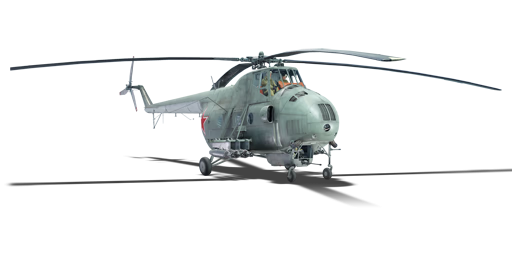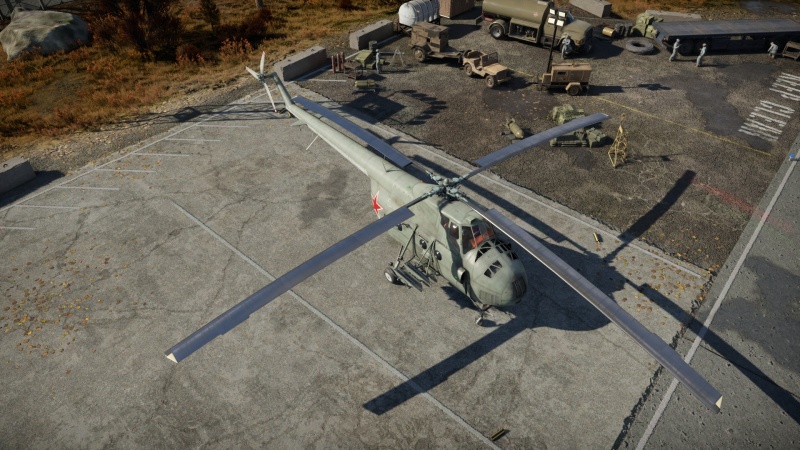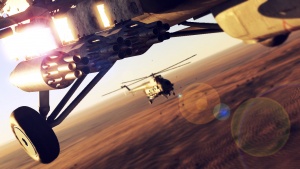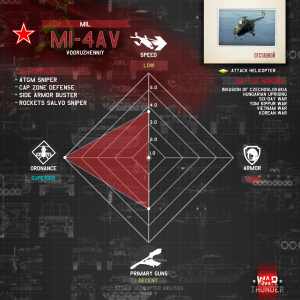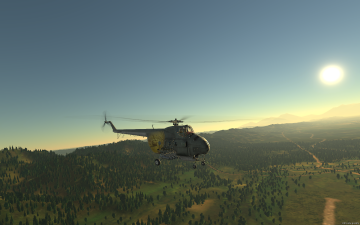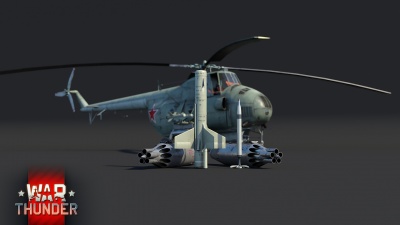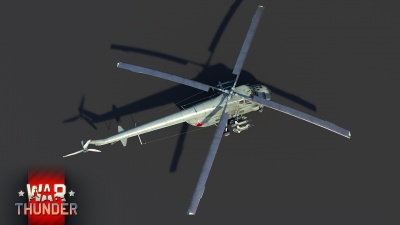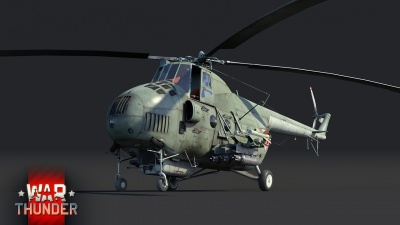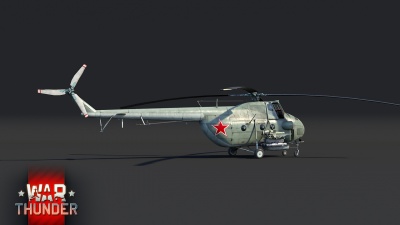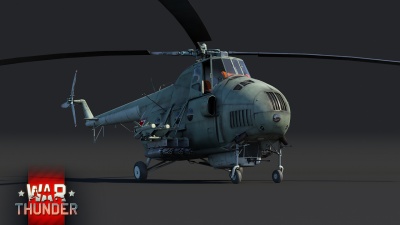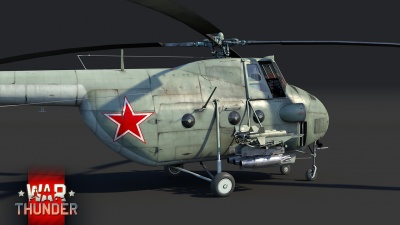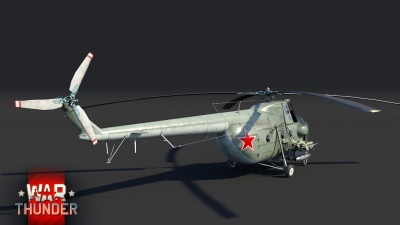Difference between revisions of "Mi-4AV"
m (Edits.) |
(Updated format) |
||
| (24 intermediate revisions by 9 users not shown) | |||
| Line 1: | Line 1: | ||
| − | {{Specs-Card|code=mi_4av}} | + | {{Specs-Card |
| + | |code=mi_4av | ||
| + | |images={{Specs-Card-Image|GarageImage_{{PAGENAME}}.jpg}} | ||
| + | }} | ||
== Description == | == Description == | ||
| − | <!--''In the description, the first part | + | <!-- ''In the description, the first part should be about the history of and the creation and combat usage of the helicopter, as well as its key features. In the second part, tell the reader about the helicopter in the game. Insert a screenshot of the vehicle, so that if the novice player does not remember the vehicle by name, he will immediately understand what kind of vehicle the article is talking about.'' --> |
| − | + | The '''{{Specs|name}}''' is a rank {{Specs|rank}} Soviet attack helicopter {{Battle-rating}}. It was introduced in [[Update 1.81 "The Valkyries"]]. | |
| − | + | ||
| − | The '''{{Specs|name}}''' is a | + | The legendary '''Mi-4''' is a pioneer in the Soviet helicopter aviation. It served as a multi-role and extremely capable helicopter for many different work fields in The Soviet Union and to many countries in the world. In the game, its combat variant the MI-4AV ''(V stands for Vooruzhennyy -armed)'' represents an honour to fly, but also a huge learning challenge. This variant entered service in 1968 with only 185 Mi-4A converted into AV armed versions. |
| + | |||
| + | Aspiring Soviet pilots will need a lot of patience, skills and tactics to master this helicopter serving as an intro for the formidable and lethal Soviet Helicopters tree. | ||
== General info == | == General info == | ||
| − | === Flight | + | === Flight performance === |
| − | <!--Describe how the | + | {{Specs-Heli-Flight}} |
| + | <!-- ''Describe how the helicopter behaves in the air. Speed, manoeuvrability, acceleration and allowable loads - these are the most important characteristics of the vehicle.'' --> | ||
| + | This helicopter is very slow; often times, you will most likely find yourself not being able to go over '''200 km/h'''. Additionally, the Mi-4AV has a poor roll rate. When fully loaded, the performance struggles more. This allows the helicopter to become an easy target for machine gun and cannons fire. Pilots should keep this in mind when choosing the payload. | ||
| − | + | The newest pilots should not attempt to tilt the rotorcraft on the roll axis more than 35°. Since the Mi-4 is heavily stiff and won't be able to handle such maneuvers. The weight will force the plane down (worst when fully loaded) and the propeller will be unable to sustain the helicopter in this awkward position, making any recovery attempts ineffective. The risk of collision by a stall and low engine thrust is significant. Is recommended the '''engine pitch''' on 80% for cruising, while 100% if ascend is needed. | |
{| class="wikitable" style="text-align:center" | {| class="wikitable" style="text-align:center" | ||
|- | |- | ||
| − | ! | + | ! rowspan="2" | Characteristics |
| − | + | ! colspan="2" | Max Speed<br>(km/h at 500 m) | |
| − | + | ! rowspan="2" | Max altitude<br>(metres) | |
| − | |||
| − | ! colspan="2" |Max Speed | ||
| − | (km/h at | ||
| − | ! rowspan="2" | Max altitude<br>( | ||
| − | |||
| − | |||
| − | |||
| − | |||
| − | |||
| − | |||
| − | |||
|- | |- | ||
| − | ! | + | ! AB !! RB |
| − | ! | ||
|- | |- | ||
| − | ! | + | ! Stock |
| − | + | | 173 || 162 || rowspan="2" | {{Specs|ceiling}} | |
|- | |- | ||
| − | | | + | ! Upgraded |
| + | | 206 || 190 | ||
|- | |- | ||
|} | |} | ||
=== Survivability and armour === | === Survivability and armour === | ||
| − | <!--''Examine the survivability of the helicopter. Note how vulnerable the structure is and how secure the pilot is, | + | {{Specs-Heli-Armour}} |
| + | <!-- ''Examine the survivability of the helicopter. Note how vulnerable the structure is and how secure the pilot is, whether the fuel tanks are armoured, etc. Describe the armour, if there is any, and also mention the vulnerability of other critical systems.'' --> | ||
The {{PAGENAME}} is a large helicopter and a big target. Unfortunately, to help keep this bird in the air and hauling troops and weapons to the battlefront, sacrifices had to be made. Here, the sacrifice was armour protection. Armour would have weighted down the already heavy helicopter, but the lack of it did not deter the Soviet Union from building these helicopters and using them on a large scale as a showcase piece of their technological prowess. The {{PAGENAME}} turned out to be a do-it-all helicopter despite not having any armour protection. | The {{PAGENAME}} is a large helicopter and a big target. Unfortunately, to help keep this bird in the air and hauling troops and weapons to the battlefront, sacrifices had to be made. Here, the sacrifice was armour protection. Armour would have weighted down the already heavy helicopter, but the lack of it did not deter the Soviet Union from building these helicopters and using them on a large scale as a showcase piece of their technological prowess. The {{PAGENAME}} turned out to be a do-it-all helicopter despite not having any armour protection. | ||
| − | The | + | The survivability on-game is average to low. With several relevant deficiencies and evident concerns, these are: |
| + | |||
| + | '''The unprotected engine is located on the front of the helicopter''' | ||
| + | |||
| + | This means once the Mi-4 starts receiving enemy fire and its engine is hit or damaged. The flight performance will decrease dramatically quickly. This will be notable when attempting to return to base after being engine damaged. The helicopter is really heavy and a damaged engine won't provide enough lift to it. Leading the Mi-4 to perform a forced landing. Besides, the fuel tanks are self-sealing, but this will be one of the least hit parts on the helicopter. | ||
| + | |||
| + | '''The overheating''' | ||
| + | |||
| + | This is yet another matter related to the weight and the engine. Even on hover mode, the helicopter will start overheating, forcing you to reduce engine power and dangerously slowing the machine. Even once fully upgraded, this remains a burden. Keep this in mind when playing on hot weather maps such as [[Sinai]] or [[Tunisia]]. | ||
| + | |||
| + | '''Big and slow target''' | ||
| + | |||
| + | Pilots need to recognize this is not a nimble and swift attack helicopter. Most guns present on its battle rating are capable of bringing it down. The helicopter is quite tough (due to spacing) and resilient to structural damage. But the poor acceleration and size mean the Mi-4 will be impacted by enemy fire constantly and quite regularly. Even at long distances, it will be clearly distinguish. | ||
| + | |||
| + | The Mi-4 is known for serving as an easy frag at the beginning of the battles. Since often, pilots will rush straight to enemy positions and end up decimated by every anti-air machine gun equipment on enemy tanks. Pilots shall avoid exactly that if they seek success on this lumbering but deadly bird. | ||
| + | |||
| + | === Modifications and economy === | ||
| + | {{Specs-Economy}} | ||
| + | |||
| + | Modifications should be acquired depending on the desired play style. | ||
| + | |||
| + | Keep in mind the importance of the Falanga ATGMs as your main armament and the need for speed conjunct with engine power. One rather easy way to use this helicopter is to play on Arcade Assault mode where you can rearm constantly and help your team against waves of enemies AI, while also researching more modules for the more challenging Mixed battles. Researching bombs will be highly useful for RP gains; against AI units like those on the Arcade Assault mode. But their use is rather limited on Mixed battles. | ||
| + | |||
| + | Enduring confrontation can allow for profit and module research, however is risky since there is a lot of more technologically superior enemies that will do quick work of you with any kind of guided missiles, with little to no chance of survival. It's up to the pilots to take these risks while they strive to research the modules completely. | ||
== Armaments == | == Armaments == | ||
| + | {{Specs-Heli-Armaments}} | ||
| + | While the flight performance and survivability are the least favorable aspects. The armaments are actually really good. Is one of the few early helicopters capable of carrying around more than 1,000kg on payload of wide variety. A certain hovering and fighting house! | ||
| + | |||
=== Offensive armament === | === Offensive armament === | ||
| − | <!--Describe the offensive armament of the | + | {{Specs-Heli-Offensive}} |
| + | <!-- ''Describe the offensive armament of the helicopter, if any. Describe how effective the cannons and machine guns are in battle, also what ammunition belts or drums are better to use. If there is no offensive weaponry, delete this subsection.'' --> | ||
{{main|A-12.7 (12.7 mm)}} | {{main|A-12.7 (12.7 mm)}} | ||
| − | + | The '''''{{PAGENAME}}''''' is armed with: | |
| + | |||
| + | * 1 x 12.7 mm A-12.7 machine gun, nose turret (900 rpg) | ||
| + | |||
| + | The {{PAGENAME}} is armed with a single flexible ''Afanasev A-12.7'' machine gun. This gun has a limited movement of only +- 30° horizontally, -55° and 8° vertically. Meaning pilots may not be able to get it on target at times. Thus needing the pilot to turn the helicopter with the yaw axis. The gun posses a decent ammo count of 900, with a high rate of fire of 1,100 rounds per minute. | ||
| + | |||
| + | For ground targets is best suited for extremely light targets which are not a common sighting at this battle rating, such as the '''[[U-SH 405]].''' It servers really well against machine gun emplacements, anti-airs and other ground targets which are light and exposed. Is worth nothing the long distances turn this gun highly ineffective. This is also induced by the absence of armor-piercing bullets with cermet core on the available belts. | ||
| + | |||
| + | The air potential of this machine gun is rather defensive. Therefore any engagements relying on this machine gun should be avoided. It works best as a defensive armament against other light and poorly frontally armored helicopters such as the Franco-German [[Alouette (Family)]], the American [[UH-1 (Family)|Hueys]] or planes you might encounter on the battlefield. | ||
| + | |||
| + | [[File:Mi-4AV convoy.jpg|thumb|{{PAGENAME}}s flying in formation carrying 96 x S-5K rockets]] | ||
=== Suspended armament === | === Suspended armament === | ||
| − | <!--Describe the | + | {{Specs-Heli-Suspended}} |
| − | {{main|FAB- | + | <!-- ''Describe the helicopter's suspended armament: additional cannons under the winglets, any bombs, and rockets. Since any helicopter is essentially only a platform for suspended weaponry, this section is significant and deserves your special attention. If there is no suspended weaponry remove this subsection.'' --> |
| + | {{main|FAB-100sv (100 kg)|FAB-250sv (250 kg)|9M17M Falanga|S-5K}} | ||
| − | The '''''{{PAGENAME}}''''' can | + | The '''''{{PAGENAME}}''''' can be outfitted with the following ordnance: |
| − | * 96 x | + | * Without load |
| − | * 6 x FAB- | + | * 96 x S-5K rockets |
| − | * 4 x FAB- | + | * 6 x 100 kg FAB-100sv bombs (600 kg total) |
| − | * 4 x 9M17M Falanga missiles | + | * 4 x 250 kg FAB-250sv bombs (1,000 kg total) |
| − | * 4 x 9M17M Falanga missiles | + | * 4 x 9M17M Falanga missiles + 96 x S-5K rockets |
| − | * 4 x 9M17M Falanga missiles | + | * 4 x 9M17M Falanga missiles + 6 x 100 kg FAB-100sv bombs (600 kg total) |
| + | * 4 x 9M17M Falanga missiles + 4 x 250 kg FAB-250sv bombs (1,000 kg total) | ||
| − | The only suspended armament it comes stock with is | + | The only suspended armament it comes stock with is 96 x S5K rockets. They can be replaced with ATGMs or bombs with latter upgrades. |
| − | + | The '''9M17M Falanga ATGMs''' are likely the staple armament pilots should seek to should equip. They will provide the ability to snipe tanks from 4 km away, without risking to get closer. | |
| − | '' | ||
| − | == | + | The '''S-5K unguided rockets''' are useful when in need to barrage an area; e.g. Enemy spawn zone or capturing point. They are not accurate but lethality can be improved through practice since the rockets are very capable. |
| − | + | ||
| − | + | '''Bombs '''use is mainly situational. This is because the bombs require the helicopter to fly by the threat, making the attacker vulnerable. They also require to be time fuzed so the Mi-4 won't get hit by the explosion. Along with the speed factor, 2.0s-3.5s of fuze delay be enough. | |
| − | + | ||
| − | + | == Usage in battles == | |
| − | + | <!-- ''Describe the tactics of playing in a helicopter, the features of using the helicopter in a team and advice on tactics. Refrain from creating a "guide" - do not impose a single point of view, but instead, give the reader food for thought. Examine the most dangerous enemies and give recommendations on fighting them. If necessary, note the specifics of the game in different modes (AB, RB, SB).'' --> | |
| − | + | Pilots should be aware this helicopter is not made for dedicated '''CAS''' ''(Close air Support)'', mainly because of some traits such as low top speed, big size, low manoeuvrability and zero countermeasures. Instead consider using it as tactical anti-tank support with mobile capacities around the allied half of the map, where it is far enough from enemy radars and anti-air vehicles. | |
| − | + | ||
| − | + | The pilots must be alert of their surroundings, as they do not want to bring undue notice upon themselves. Ending being downed by a plane is a common situation. Strategy plays key in this helicopters ability to sneak into position, let loose a volley of rockets or zero-in an anti-tank guided missile onto an unsuspecting target. Use structures and terrain to act as shields when possible. | |
| − | + | ||
| − | + | === '''Mixed battles''' === | |
| − | + | It might be wise to use this helicopter only for '''ATGM''' duties in most long open maps, while benefiting from the '''rocket pods''' or '''bombs''' in close and cramped maps. Stay away from enemy tank packs and hunt light tanks flanking your team on the sides of the map with the rockets pods, or load ATGMs and become an efficient '''4 km''' sniper. Multiple tactics for different maps. Trial and error should be made to ensure self-survival and team victory. | |
| − | + | ||
| − | + | Do not forget to watch for any enemy aircraft spawning and be ready to swiftly return to base. Avoid staying around too much since helicopters are easily noticeable by sound and will be quickly taken down. Consider using this helicopter to control enemy offensives and defend points with ATGMs. | |
| − | + | ||
| − | + | '''Night battles''' | |
| − | + | ||
| − | + | Night battles, is possibly a decent moment to spawn with the Mi-4. Thanks to the NVD equipment, it has the visual upper hand against planes. The darker and the worst visibility, the easier will be for pilots on the Mi-4 to perform daring attacks. Always keeping in mind there are radars on the line, waiting for aerial threats. Stick to the Mi-4's rules of engagement during the daylight and you likely succeed. | |
| − | | | + | |
| − | + | '''Enemies worth noting''' | |
| − | + | ||
| − | + | Just like it was historically considered, the NATO's tank represent the greater threat to the Soviet helicopter pilots. | |
| − | + | ||
| − | + | [[Gepard]] and [[Chieftain Marksman]]: The Marksman anti-air system available on these anti-aircraft is really dangerous on medium-long distances. With powerful radar, high turret rotation speed, and lethal cannons. They can open fire even before soviet pilots cross the horizon of the landscape thanks to their radar fire predictor. This is completely antagonistic for Mi-4's low speed and big size. The best odds is to make them a priority target and let loose a rapid rocket salvo. Their turrets are huge and with low armor, Mi-4's rockets will be capable of a precise dispatch. | |
| − | + | ||
| − | + | [[SIDAM 25]]: This Italian anti-aircraft's 4 cannons are extremely dangerous for your close attacks. They especially deadly on close-medium distances. The small size of this tank compared to other NATO's AAs make it harder to spot and once you get hit, it's unlikely you survive. As with most of the anti-aircrafts, they have poor armor. Use an unguided rockets salvo to make them run for cover or take advantage of the long-range of your Falanga missiles. | |
| − | + | ||
| − | + | [[M3 Bradley|Bradley]], [[Warrior]] and [[Begleitpanzer 57|Begleitpanzer]]: These American, British, and German IFVs are not only threatening to ground vehicles, but also for low flying aircraft. They are well-armed, they equip a modern system of thermal optics and they are highly mobile. This means they will find helicopters comfortably anywhere on the map during the day or night and attempt to bring them down very hastily with their auto-cannons, ATGMs or time fuzed shells. The stealth and distance element is your best advantage versus them, avoid hurrying into the battle from obvious helicopter spawn points, instead opt for a short flank then get just barely altitude to engage them. Using things like trees and mountains as your reliable cover. | |
| + | |||
| + | === Role in the team === | ||
| + | Once the Soviet Mi-4 pilots choose to spawn, there are several points they need to prioritize to actively boost their team during the battle. | ||
| + | |||
| + | * Where on the map are the enemy forces? | ||
| + | * Where on the map our forces need air support? (attempting to capture a zone for example) | ||
| + | * Is one of our capture points in need for defense? (quite often the enemy will even seize allied spawn point) | ||
| + | |||
| + | This will now let pilots ponder about how to engage, race slowly in, or stay far and use the Falanga ATGMs. The prudent tactic is usually to stay far but this may differ on different maps. Their role in the team can go about the ability to spot the threats from a greater and higher angle than the ground forces teammates. Effecting things such as opening a rocket salvo on a quick enemy flanker will enable the team to notice and destroy the threat. If the Mi-4 hasn't yet. The 4 Falanga can be put to good use on skilled hands, defeating 4 enemies with them will surely setback the enemy's spawn points. Mi-4's '''S-5K''' can be used to suppress the enemy groups pushing, on urban maps for example. If the battlefield is safe or uncared enough, the helicopter is fully able to capture a distant point by landing inside it. Possibly, coordinate with the allied fixed-wing aviation for a multi-directional attack on the opponent's anti-aircraft locations. | ||
| + | |||
| + | Spawning, closing in, sighting, and engaging targets then retreating to then repeat. This all should be potential tactics to survive and actively support the team during the battle. | ||
| + | |||
| + | Also remember that; | ||
| − | + | * Despite the natural difficulties of the mode, Simulator mode is greatly rewarding due to the stealth element. Situationally allows to execute a more offensive close approach. | |
| − | + | * The pilots should promote the habit of checking for enemy planes up before spawning. This will avoid imminent annihilation by enemy planes already on air. | |
| + | * A group of Mi-4 is more like to survive than a single Mi-4. Don't be irresolute to call for backups or communicate with your teammates for a coordinated attack. | ||
| + | === Pros and cons === | ||
| + | <!-- ''Summarise and briefly evaluate the vehicle in terms of its characteristics and combat effectiveness. Mark its pros and cons in the bulleted list. Try not to use more than 6 points for each of the characteristics. Avoid using categorical definitions such as "bad", "good" and the like - use substitutions with softer forms such as "inadequate" and "effective".'' --> | ||
| + | [[File:Radar_chart_Mi-4AV.png|thumb|Mi-4AV's attack helicopter capacities]] | ||
'''Pros:''' | '''Pros:''' | ||
| − | * Workhorse | + | * Workhorse multipurpose machine (rockets, 100-250kg bombs, ATGMs, turret and NVD) |
| − | * | + | * Superior external payload options than other rank V helicopters, along the [[Mi-24 (Family)]] |
| + | * Quite resilient | ||
| + | * Can carry '''Falanga''' ATGMs with 4 km of firing range | ||
| + | * 12.7 mm turret for light defences, light vehicles, and any poorly armored aircraft | ||
| + | * Large numbers of S-5K unguided rockets | ||
'''Cons:''' | '''Cons:''' | ||
| − | * No armour or bullet-proof glass | + | * No armour or bullet-proof glass with critical components co-located (cockpit, engine, motor and oil coolers) |
| − | + | * Huge, slow and not very manoeuvrable | |
| − | * | + | * ATGM targeting range is narrow (difficulties when tracking a target may arise) |
| + | * Unforgiving playstyle due to vital deficiencies as an attack helicopter. | ||
| + | * No Gyro-stabilization system for simulator modes, this makes the machine more unstable | ||
== History == | == History == | ||
| − | <!--''Describe the history of the creation and combat usage of the helicopter in more detail than in the introduction. If the historical reference turns out to be too | + | <!-- ''Describe the history of the creation and combat usage of the helicopter in more detail than in the introduction. If the historical reference turns out to be too long, take it to a separate article, taking a link to the article about the vehicle and adding a block "/History" (example: <nowiki>https://wiki.warthunder.com/(Vehicle-name)/History</nowiki>) and add a link to it here using the <code>main</code> template. Be sure to reference text and sources by using <code><nowiki><ref></ref></nowiki></code>, as well as adding them at the end of the article with <code><nowiki><references /></nowiki></code>. This section may also include the vehicle's dev blog entry (if applicable) and the in-game encyclopedia description (under <code><nowiki>=== In-game description ===</nowiki></code>, also if applicable).'' --> |
The Soviet Army Aviation owes its emergence mostly to the transport landing helicopter Mi-4. The Mi-4 paved the way for helicopter usage in the Soviet national armed forces. | The Soviet Army Aviation owes its emergence mostly to the transport landing helicopter Mi-4. The Mi-4 paved the way for helicopter usage in the Soviet national armed forces. | ||
| + | |||
The Korean War was the main impetus in which provided the need for a Mi-4 helicopter which started its official development in the early 1950s. At the time, the American military was widely using helicopters as a force multiplier which enabled troops to advance and reinforce areas much quicker than when travelling by vehicle or more to a pinpoint location without needing finding or building an airfield. Through the use of helicopters, rapid and large scale operations became a possibility that had yet to be exploited to its fullest. At this time, the Americans were using different types of helicopters to do various tasks, depending on what payload was needed. Light helicopters were used for duties such as taking wounded back to hospitals, means of communication and spotters for artillery units. More massive helicopters were utilised for delivering troops, vehicles, supplies and artillery directly to the battlefield. The Korean War demonstrated the increased need for a role which rotor vehicles could fulfil within the Armed Forces. | The Korean War was the main impetus in which provided the need for a Mi-4 helicopter which started its official development in the early 1950s. At the time, the American military was widely using helicopters as a force multiplier which enabled troops to advance and reinforce areas much quicker than when travelling by vehicle or more to a pinpoint location without needing finding or building an airfield. Through the use of helicopters, rapid and large scale operations became a possibility that had yet to be exploited to its fullest. At this time, the Americans were using different types of helicopters to do various tasks, depending on what payload was needed. Light helicopters were used for duties such as taking wounded back to hospitals, means of communication and spotters for artillery units. More massive helicopters were utilised for delivering troops, vehicles, supplies and artillery directly to the battlefield. The Korean War demonstrated the increased need for a role which rotor vehicles could fulfil within the Armed Forces. | ||
| − | Once realising their folly of not developing helicopters for inclusion in the armed forces, Soviet leadership decided they needed to make up for lost time and get to work designing and building their helicopter force. In October 1951, the leading aviation designers of the Soviet Union were called to the Kremlin. As a result of the meeting, tasks for developing new rotor vehicles were given to the aviation designers. Here, the Mil Design Bureau specifically was assigned to the designing and creating a landing-transport helicopter which could carry up to 12 persons. Quick work was needed because experimental models were required to be ready for trials one year after receiving this assignment. | + | Once realising their folly of not developing helicopters for inclusion in the armed forces, Soviet leadership decided they needed to make up for lost time and get to work designing and building their helicopter force. In October 1951, the leading aviation designers of the Soviet Union were called to the Kremlin. As a result of the meeting, tasks for developing new rotor vehicles were given to the aviation designers. Here, the Mil Design Bureau specifically was assigned to the designing and creating a landing-transport helicopter which could carry up to 12 persons. Quick work was needed because experimental models were required to be ready for trials one year after receiving this assignment. |
| − | Mikhail Mil began to work on a solution; however, unbeknownst to many, he already had a head start on this project which he called the VD-12 or Vertolyot Desantniy (a landing helicopter) which was designed to hold 12 persons. The design of Mikhail | + | Mikhail Mil began to work on a solution; however, unbeknownst to many, he already had a head start on this project which he called the VD-12 or Vertolyot Desantniy (a landing helicopter) which was designed to hold 12 persons. The design of Mikhail Mil's had been around since the end of the 40s. However, it never went anywhere because nobody was willing to support the project at the time. The lack of support extended from the military through the highest leadership in the country because they did not understand the battlefield benefits this tool would provide their soldiers. It wasn't until the Soviets were spectators in the Korean War that they saw firsthand the effectiveness of helicopters on the battlefield. |
Initially the VD-12 was designed to receive a 1,000 HP engine; however, when the helicopter was ready to begin construction and to receive it, the engine was determined not to be ready for the deadline trials. Mil was then required to redesign the VD-12 to accept a more powerful and heavy engine, the Ash-82 developed by Arkadiy Shevetsov which was a couple of generations newer than the Ash-73TK utilised on the Tu-4 bomber. This piston engine had proven itself an excellent engine when employed on various aeroplanes. To accept this new engine, the helicopter needed to be enlarged to adequately encompass it. Yakovlev DB had intended on providing the rotor, main rotor head, wobble plate, reduction gear and engine for the project, however that was for the smaller VD-12 and all that had to be scrapped for the newer and larger helicopter. Igor Sikorsky developed the S-55 (H-19) which was very similar in size and layout, and Mil decided to model the more modern and larger helicopter off of the aspects of the S-55 which applied to his larger helicopter. The Radial engine was placed in the front nose with the drive shaft passing through the cockpit and turning the rotor, which left the lower section of the helicopter to be a large cargo cabin. Again the cabin needed to be able to hold 12 troops or various military equipment which weighed up to 1,600 kg. | Initially the VD-12 was designed to receive a 1,000 HP engine; however, when the helicopter was ready to begin construction and to receive it, the engine was determined not to be ready for the deadline trials. Mil was then required to redesign the VD-12 to accept a more powerful and heavy engine, the Ash-82 developed by Arkadiy Shevetsov which was a couple of generations newer than the Ash-73TK utilised on the Tu-4 bomber. This piston engine had proven itself an excellent engine when employed on various aeroplanes. To accept this new engine, the helicopter needed to be enlarged to adequately encompass it. Yakovlev DB had intended on providing the rotor, main rotor head, wobble plate, reduction gear and engine for the project, however that was for the smaller VD-12 and all that had to be scrapped for the newer and larger helicopter. Igor Sikorsky developed the S-55 (H-19) which was very similar in size and layout, and Mil decided to model the more modern and larger helicopter off of the aspects of the S-55 which applied to his larger helicopter. The Radial engine was placed in the front nose with the drive shaft passing through the cockpit and turning the rotor, which left the lower section of the helicopter to be a large cargo cabin. Again the cabin needed to be able to hold 12 troops or various military equipment which weighed up to 1,600 kg. | ||
| Line 127: | Line 186: | ||
With this plan in action, designers were working almost around the clock to complete the schematics. Within four months of the project starting, the prototype was rolled out of the hanger and prepped for flight. With the radial engine firing, the rotor began to spin, however during acceleration of the motor; the blades started to bend severely, threatening to break apart and destroy the helicopter. The rotor was powered down, and the minds went to work attempting to figure out what the issue was. Mil settled on the problem being the rotors fluttering, which for aircraft surfaces bending or flexion which causes material fatigue and the parts disintegrate thus destroying the entire project. To validate this theory, special weights were built in one night and then installed on the blades. A repeat of the experiment was conducted, and the rotor behaved in a manner it needed to work correctly. Further testing created a blade which was constructed to eliminate any flutter. | With this plan in action, designers were working almost around the clock to complete the schematics. Within four months of the project starting, the prototype was rolled out of the hanger and prepped for flight. With the radial engine firing, the rotor began to spin, however during acceleration of the motor; the blades started to bend severely, threatening to break apart and destroy the helicopter. The rotor was powered down, and the minds went to work attempting to figure out what the issue was. Mil settled on the problem being the rotors fluttering, which for aircraft surfaces bending or flexion which causes material fatigue and the parts disintegrate thus destroying the entire project. To validate this theory, special weights were built in one night and then installed on the blades. A repeat of the experiment was conducted, and the rotor behaved in a manner it needed to work correctly. Further testing created a blade which was constructed to eliminate any flutter. | ||
| − | Seven months after receiving their assignment to develop and build a helicopter, the first helicopter trials were ready to begin. While the first test had the helicopter tethered to the ground to prevent any mishaps, on the 3rd of June, Vsevolod Vinnitskiy made the first free flight in the new helicopter. At this point, the VD-12 was the most significant and most massive lifting helicopter in the World. With the completion of the | + | Seven months after receiving their assignment to develop and build a helicopter, the first helicopter trials were ready to begin. While the first test had the helicopter tethered to the ground to prevent any mishaps, on the 3rd of June, Vsevolod Vinnitskiy made the first free flight in the new helicopter. At this point, the VD-12 was the most significant and most massive lifting helicopter in the World. With the completion of the state's trials, the VD-12 began mass production, and its name was changed to Mi-4 and was introduced into service the next year. |
| − | In many ways the Mi-4 surpassed the US helicopter H- | + | In many ways the Mi-4 surpassed the US helicopter H-19's capabilities as the rear of the Mi-4 could open up and through the use of a ramp, men, vehicles and artillery could quickly be loaded and unloaded. Also installed under the nose of the helicopter was a gunner position with a 12.7 mm machine gun. The Soviet military found many uses for the new helicopter beyond just transporting people and equipment, and as more equipment was outfitted, the helicopter also took on roles such as ground attack and submarine hunter. More than 3,000 Mi-4 helicopters were produced during its years in service and proved to be an essential force multiplier on the battlefield for the Soviet Armed Forces. |
== Media == | == Media == | ||
<!-- ''Excellent additions to the article would be video guides, screenshots from the game, and photos.'' --> | <!-- ''Excellent additions to the article would be video guides, screenshots from the game, and photos.'' --> | ||
| + | |||
| + | ;Skins | ||
| + | |||
| + | * [https://live.warthunder.com/feed/camouflages/?vehicleCountry=ussr&vehicleType=helicopter&vehicleClass=attack_helicopter&vehicle=mi_4av Skins and camouflages for the {{PAGENAME}} from live.warthunder.com.] | ||
| + | |||
;Images | ;Images | ||
| − | + | ||
| − | < | + | <gallery mode="packed" heights="150"> |
| − | + | File:MI-4AV userphoto 1.png| | |
| − | + | File:Mi-4AV WTWallpaper 001.jpg| | |
| − | + | File:Mi-4AV WTWallpaper 002.jpg| | |
| − | + | File:Mi-4AV WTWallpaper 003.jpg| | |
| − | + | File:Mi-4AV WTWallpaper 004.jpg| | |
| − | + | File:Mi-4AV WTWallpaper 005.jpg| | |
| − | + | File:Mi-4AV WTWallpaper 006.jpg| | |
| + | File:Mi-4AV WTWallpaper 007.jpg| | ||
| + | </gallery> | ||
| + | |||
;Videos | ;Videos | ||
| − | {{Youtube-gallery|Ndj0AenHKN8|Mi-4 Transport Helicopter - | + | {{Youtube-gallery|lTR8bhL4BUc|'''The Mi-24 Family''' discusses the {{PAGENAME}} at 0:47 - ''War Thunder Official Channel''|h_Gng-eiEXE|'''The Shooting Range #113''' - ''Pages of History'' section at 06:00 discusses the Mi-4AV.|Ndj0AenHKN8|'''Mil Mi-4 Transport Helicopter Making Of - MADE in the USSR''' - ''Epic Soviet Documentaries''}} |
== See also == | == See also == | ||
| − | <!--''Links to the articles on the War Thunder Wiki that you think will be useful for the reader, for example:'' | + | <!-- ''Links to the articles on the War Thunder Wiki that you think will be useful for the reader, for example:'' |
* ''reference to the series of the helicopter;'' | * ''reference to the series of the helicopter;'' | ||
| − | * ''links to approximate analogues of other nations and research trees.''--> | + | * ''links to approximate analogues of other nations and research trees.'' --> |
| + | |||
;Aircraft of comparable role, configuration and era | ;Aircraft of comparable role, configuration and era | ||
| − | * Sikorsky [[H-34]] Choctaw | + | |
| + | * [[H-34]] - Sikorsky Choctaw | ||
| + | * [[H-34 (France)]] - French variant of the Choctaw | ||
== External links == | == External links == | ||
| − | <!--''Paste links to sources and external resources, such as:'' | + | <!-- ''Paste links to sources and external resources, such as:'' |
* ''topic on the official game forum;'' | * ''topic on the official game forum;'' | ||
| − | * ''encyclopedia page on helicopter;'' | + | * ''encyclopedia page on the helicopter;'' |
| − | * ''other literature.''--> | + | * ''other literature.'' --> |
| − | * [ | + | * [[wt:en/news/5708-development-uh-1-and-mi-4-early-birds-en|[Devblog] UH-1 and Mi-4: Early Birds]] |
| + | {{AirManufacturer Mil}} | ||
{{USSR helicopters}} | {{USSR helicopters}} | ||
Revision as of 14:04, 25 December 2020
Contents
Description
The Mi-4AV is a rank V Soviet attack helicopter with a battle rating of 8.7 (AB), 8.0 (RB), and 8.3 (SB). It was introduced in Update 1.81 "The Valkyries".
The legendary Mi-4 is a pioneer in the Soviet helicopter aviation. It served as a multi-role and extremely capable helicopter for many different work fields in The Soviet Union and to many countries in the world. In the game, its combat variant the MI-4AV (V stands for Vooruzhennyy -armed) represents an honour to fly, but also a huge learning challenge. This variant entered service in 1968 with only 185 Mi-4A converted into AV armed versions.
Aspiring Soviet pilots will need a lot of patience, skills and tactics to master this helicopter serving as an intro for the formidable and lethal Soviet Helicopters tree.
General info
Flight performance
This helicopter is very slow; often times, you will most likely find yourself not being able to go over 200 km/h. Additionally, the Mi-4AV has a poor roll rate. When fully loaded, the performance struggles more. This allows the helicopter to become an easy target for machine gun and cannons fire. Pilots should keep this in mind when choosing the payload.
The newest pilots should not attempt to tilt the rotorcraft on the roll axis more than 35°. Since the Mi-4 is heavily stiff and won't be able to handle such maneuvers. The weight will force the plane down (worst when fully loaded) and the propeller will be unable to sustain the helicopter in this awkward position, making any recovery attempts ineffective. The risk of collision by a stall and low engine thrust is significant. Is recommended the engine pitch on 80% for cruising, while 100% if ascend is needed.
| Characteristics | Max Speed (km/h at 500 m) |
Max altitude (metres) | |
|---|---|---|---|
| AB | RB | ||
| Stock | 173 | 162 | 6000 |
| Upgraded | 206 | 190 | |
Survivability and armour
The Mi-4AV is a large helicopter and a big target. Unfortunately, to help keep this bird in the air and hauling troops and weapons to the battlefront, sacrifices had to be made. Here, the sacrifice was armour protection. Armour would have weighted down the already heavy helicopter, but the lack of it did not deter the Soviet Union from building these helicopters and using them on a large scale as a showcase piece of their technological prowess. The Mi-4AV turned out to be a do-it-all helicopter despite not having any armour protection.
The survivability on-game is average to low. With several relevant deficiencies and evident concerns, these are:
The unprotected engine is located on the front of the helicopter
This means once the Mi-4 starts receiving enemy fire and its engine is hit or damaged. The flight performance will decrease dramatically quickly. This will be notable when attempting to return to base after being engine damaged. The helicopter is really heavy and a damaged engine won't provide enough lift to it. Leading the Mi-4 to perform a forced landing. Besides, the fuel tanks are self-sealing, but this will be one of the least hit parts on the helicopter.
The overheating
This is yet another matter related to the weight and the engine. Even on hover mode, the helicopter will start overheating, forcing you to reduce engine power and dangerously slowing the machine. Even once fully upgraded, this remains a burden. Keep this in mind when playing on hot weather maps such as Sinai or Tunisia.
Big and slow target
Pilots need to recognize this is not a nimble and swift attack helicopter. Most guns present on its battle rating are capable of bringing it down. The helicopter is quite tough (due to spacing) and resilient to structural damage. But the poor acceleration and size mean the Mi-4 will be impacted by enemy fire constantly and quite regularly. Even at long distances, it will be clearly distinguish.
The Mi-4 is known for serving as an easy frag at the beginning of the battles. Since often, pilots will rush straight to enemy positions and end up decimated by every anti-air machine gun equipment on enemy tanks. Pilots shall avoid exactly that if they seek success on this lumbering but deadly bird.
Modifications and economy
Modifications should be acquired depending on the desired play style.
Keep in mind the importance of the Falanga ATGMs as your main armament and the need for speed conjunct with engine power. One rather easy way to use this helicopter is to play on Arcade Assault mode where you can rearm constantly and help your team against waves of enemies AI, while also researching more modules for the more challenging Mixed battles. Researching bombs will be highly useful for RP gains; against AI units like those on the Arcade Assault mode. But their use is rather limited on Mixed battles.
Enduring confrontation can allow for profit and module research, however is risky since there is a lot of more technologically superior enemies that will do quick work of you with any kind of guided missiles, with little to no chance of survival. It's up to the pilots to take these risks while they strive to research the modules completely.
Armaments
While the flight performance and survivability are the least favorable aspects. The armaments are actually really good. Is one of the few early helicopters capable of carrying around more than 1,000kg on payload of wide variety. A certain hovering and fighting house!
Offensive armament
The Mi-4AV is armed with:
- 1 x 12.7 mm A-12.7 machine gun, nose turret (900 rpg)
The Mi-4AV is armed with a single flexible Afanasev A-12.7 machine gun. This gun has a limited movement of only +- 30° horizontally, -55° and 8° vertically. Meaning pilots may not be able to get it on target at times. Thus needing the pilot to turn the helicopter with the yaw axis. The gun posses a decent ammo count of 900, with a high rate of fire of 1,100 rounds per minute.
For ground targets is best suited for extremely light targets which are not a common sighting at this battle rating, such as the U-SH 405. It servers really well against machine gun emplacements, anti-airs and other ground targets which are light and exposed. Is worth nothing the long distances turn this gun highly ineffective. This is also induced by the absence of armor-piercing bullets with cermet core on the available belts.
The air potential of this machine gun is rather defensive. Therefore any engagements relying on this machine gun should be avoided. It works best as a defensive armament against other light and poorly frontally armored helicopters such as the Franco-German Alouette (Family), the American Hueys or planes you might encounter on the battlefield.
Suspended armament
The Mi-4AV can be outfitted with the following ordnance:
- Without load
- 96 x S-5K rockets
- 6 x 100 kg FAB-100sv bombs (600 kg total)
- 4 x 250 kg FAB-250sv bombs (1,000 kg total)
- 4 x 9M17M Falanga missiles + 96 x S-5K rockets
- 4 x 9M17M Falanga missiles + 6 x 100 kg FAB-100sv bombs (600 kg total)
- 4 x 9M17M Falanga missiles + 4 x 250 kg FAB-250sv bombs (1,000 kg total)
The only suspended armament it comes stock with is 96 x S5K rockets. They can be replaced with ATGMs or bombs with latter upgrades.
The 9M17M Falanga ATGMs are likely the staple armament pilots should seek to should equip. They will provide the ability to snipe tanks from 4 km away, without risking to get closer.
The S-5K unguided rockets are useful when in need to barrage an area; e.g. Enemy spawn zone or capturing point. They are not accurate but lethality can be improved through practice since the rockets are very capable.
Bombs use is mainly situational. This is because the bombs require the helicopter to fly by the threat, making the attacker vulnerable. They also require to be time fuzed so the Mi-4 won't get hit by the explosion. Along with the speed factor, 2.0s-3.5s of fuze delay be enough.
Usage in battles
Pilots should be aware this helicopter is not made for dedicated CAS (Close air Support), mainly because of some traits such as low top speed, big size, low manoeuvrability and zero countermeasures. Instead consider using it as tactical anti-tank support with mobile capacities around the allied half of the map, where it is far enough from enemy radars and anti-air vehicles.
The pilots must be alert of their surroundings, as they do not want to bring undue notice upon themselves. Ending being downed by a plane is a common situation. Strategy plays key in this helicopters ability to sneak into position, let loose a volley of rockets or zero-in an anti-tank guided missile onto an unsuspecting target. Use structures and terrain to act as shields when possible.
Mixed battles
It might be wise to use this helicopter only for ATGM duties in most long open maps, while benefiting from the rocket pods or bombs in close and cramped maps. Stay away from enemy tank packs and hunt light tanks flanking your team on the sides of the map with the rockets pods, or load ATGMs and become an efficient 4 km sniper. Multiple tactics for different maps. Trial and error should be made to ensure self-survival and team victory.
Do not forget to watch for any enemy aircraft spawning and be ready to swiftly return to base. Avoid staying around too much since helicopters are easily noticeable by sound and will be quickly taken down. Consider using this helicopter to control enemy offensives and defend points with ATGMs.
Night battles
Night battles, is possibly a decent moment to spawn with the Mi-4. Thanks to the NVD equipment, it has the visual upper hand against planes. The darker and the worst visibility, the easier will be for pilots on the Mi-4 to perform daring attacks. Always keeping in mind there are radars on the line, waiting for aerial threats. Stick to the Mi-4's rules of engagement during the daylight and you likely succeed.
Enemies worth noting
Just like it was historically considered, the NATO's tank represent the greater threat to the Soviet helicopter pilots.
Gepard and Chieftain Marksman: The Marksman anti-air system available on these anti-aircraft is really dangerous on medium-long distances. With powerful radar, high turret rotation speed, and lethal cannons. They can open fire even before soviet pilots cross the horizon of the landscape thanks to their radar fire predictor. This is completely antagonistic for Mi-4's low speed and big size. The best odds is to make them a priority target and let loose a rapid rocket salvo. Their turrets are huge and with low armor, Mi-4's rockets will be capable of a precise dispatch.
SIDAM 25: This Italian anti-aircraft's 4 cannons are extremely dangerous for your close attacks. They especially deadly on close-medium distances. The small size of this tank compared to other NATO's AAs make it harder to spot and once you get hit, it's unlikely you survive. As with most of the anti-aircrafts, they have poor armor. Use an unguided rockets salvo to make them run for cover or take advantage of the long-range of your Falanga missiles.
Bradley, Warrior and Begleitpanzer: These American, British, and German IFVs are not only threatening to ground vehicles, but also for low flying aircraft. They are well-armed, they equip a modern system of thermal optics and they are highly mobile. This means they will find helicopters comfortably anywhere on the map during the day or night and attempt to bring them down very hastily with their auto-cannons, ATGMs or time fuzed shells. The stealth and distance element is your best advantage versus them, avoid hurrying into the battle from obvious helicopter spawn points, instead opt for a short flank then get just barely altitude to engage them. Using things like trees and mountains as your reliable cover.
Role in the team
Once the Soviet Mi-4 pilots choose to spawn, there are several points they need to prioritize to actively boost their team during the battle.
- Where on the map are the enemy forces?
- Where on the map our forces need air support? (attempting to capture a zone for example)
- Is one of our capture points in need for defense? (quite often the enemy will even seize allied spawn point)
This will now let pilots ponder about how to engage, race slowly in, or stay far and use the Falanga ATGMs. The prudent tactic is usually to stay far but this may differ on different maps. Their role in the team can go about the ability to spot the threats from a greater and higher angle than the ground forces teammates. Effecting things such as opening a rocket salvo on a quick enemy flanker will enable the team to notice and destroy the threat. If the Mi-4 hasn't yet. The 4 Falanga can be put to good use on skilled hands, defeating 4 enemies with them will surely setback the enemy's spawn points. Mi-4's S-5K can be used to suppress the enemy groups pushing, on urban maps for example. If the battlefield is safe or uncared enough, the helicopter is fully able to capture a distant point by landing inside it. Possibly, coordinate with the allied fixed-wing aviation for a multi-directional attack on the opponent's anti-aircraft locations.
Spawning, closing in, sighting, and engaging targets then retreating to then repeat. This all should be potential tactics to survive and actively support the team during the battle.
Also remember that;
- Despite the natural difficulties of the mode, Simulator mode is greatly rewarding due to the stealth element. Situationally allows to execute a more offensive close approach.
- The pilots should promote the habit of checking for enemy planes up before spawning. This will avoid imminent annihilation by enemy planes already on air.
- A group of Mi-4 is more like to survive than a single Mi-4. Don't be irresolute to call for backups or communicate with your teammates for a coordinated attack.
Pros and cons
Pros:
- Workhorse multipurpose machine (rockets, 100-250kg bombs, ATGMs, turret and NVD)
- Superior external payload options than other rank V helicopters, along the Mi-24 (Family)
- Quite resilient
- Can carry Falanga ATGMs with 4 km of firing range
- 12.7 mm turret for light defences, light vehicles, and any poorly armored aircraft
- Large numbers of S-5K unguided rockets
Cons:
- No armour or bullet-proof glass with critical components co-located (cockpit, engine, motor and oil coolers)
- Huge, slow and not very manoeuvrable
- ATGM targeting range is narrow (difficulties when tracking a target may arise)
- Unforgiving playstyle due to vital deficiencies as an attack helicopter.
- No Gyro-stabilization system for simulator modes, this makes the machine more unstable
History
The Soviet Army Aviation owes its emergence mostly to the transport landing helicopter Mi-4. The Mi-4 paved the way for helicopter usage in the Soviet national armed forces.
The Korean War was the main impetus in which provided the need for a Mi-4 helicopter which started its official development in the early 1950s. At the time, the American military was widely using helicopters as a force multiplier which enabled troops to advance and reinforce areas much quicker than when travelling by vehicle or more to a pinpoint location without needing finding or building an airfield. Through the use of helicopters, rapid and large scale operations became a possibility that had yet to be exploited to its fullest. At this time, the Americans were using different types of helicopters to do various tasks, depending on what payload was needed. Light helicopters were used for duties such as taking wounded back to hospitals, means of communication and spotters for artillery units. More massive helicopters were utilised for delivering troops, vehicles, supplies and artillery directly to the battlefield. The Korean War demonstrated the increased need for a role which rotor vehicles could fulfil within the Armed Forces.
Once realising their folly of not developing helicopters for inclusion in the armed forces, Soviet leadership decided they needed to make up for lost time and get to work designing and building their helicopter force. In October 1951, the leading aviation designers of the Soviet Union were called to the Kremlin. As a result of the meeting, tasks for developing new rotor vehicles were given to the aviation designers. Here, the Mil Design Bureau specifically was assigned to the designing and creating a landing-transport helicopter which could carry up to 12 persons. Quick work was needed because experimental models were required to be ready for trials one year after receiving this assignment.
Mikhail Mil began to work on a solution; however, unbeknownst to many, he already had a head start on this project which he called the VD-12 or Vertolyot Desantniy (a landing helicopter) which was designed to hold 12 persons. The design of Mikhail Mil's had been around since the end of the 40s. However, it never went anywhere because nobody was willing to support the project at the time. The lack of support extended from the military through the highest leadership in the country because they did not understand the battlefield benefits this tool would provide their soldiers. It wasn't until the Soviets were spectators in the Korean War that they saw firsthand the effectiveness of helicopters on the battlefield.
Initially the VD-12 was designed to receive a 1,000 HP engine; however, when the helicopter was ready to begin construction and to receive it, the engine was determined not to be ready for the deadline trials. Mil was then required to redesign the VD-12 to accept a more powerful and heavy engine, the Ash-82 developed by Arkadiy Shevetsov which was a couple of generations newer than the Ash-73TK utilised on the Tu-4 bomber. This piston engine had proven itself an excellent engine when employed on various aeroplanes. To accept this new engine, the helicopter needed to be enlarged to adequately encompass it. Yakovlev DB had intended on providing the rotor, main rotor head, wobble plate, reduction gear and engine for the project, however that was for the smaller VD-12 and all that had to be scrapped for the newer and larger helicopter. Igor Sikorsky developed the S-55 (H-19) which was very similar in size and layout, and Mil decided to model the more modern and larger helicopter off of the aspects of the S-55 which applied to his larger helicopter. The Radial engine was placed in the front nose with the drive shaft passing through the cockpit and turning the rotor, which left the lower section of the helicopter to be a large cargo cabin. Again the cabin needed to be able to hold 12 troops or various military equipment which weighed up to 1,600 kg.
With this plan in action, designers were working almost around the clock to complete the schematics. Within four months of the project starting, the prototype was rolled out of the hanger and prepped for flight. With the radial engine firing, the rotor began to spin, however during acceleration of the motor; the blades started to bend severely, threatening to break apart and destroy the helicopter. The rotor was powered down, and the minds went to work attempting to figure out what the issue was. Mil settled on the problem being the rotors fluttering, which for aircraft surfaces bending or flexion which causes material fatigue and the parts disintegrate thus destroying the entire project. To validate this theory, special weights were built in one night and then installed on the blades. A repeat of the experiment was conducted, and the rotor behaved in a manner it needed to work correctly. Further testing created a blade which was constructed to eliminate any flutter.
Seven months after receiving their assignment to develop and build a helicopter, the first helicopter trials were ready to begin. While the first test had the helicopter tethered to the ground to prevent any mishaps, on the 3rd of June, Vsevolod Vinnitskiy made the first free flight in the new helicopter. At this point, the VD-12 was the most significant and most massive lifting helicopter in the World. With the completion of the state's trials, the VD-12 began mass production, and its name was changed to Mi-4 and was introduced into service the next year.
In many ways the Mi-4 surpassed the US helicopter H-19's capabilities as the rear of the Mi-4 could open up and through the use of a ramp, men, vehicles and artillery could quickly be loaded and unloaded. Also installed under the nose of the helicopter was a gunner position with a 12.7 mm machine gun. The Soviet military found many uses for the new helicopter beyond just transporting people and equipment, and as more equipment was outfitted, the helicopter also took on roles such as ground attack and submarine hunter. More than 3,000 Mi-4 helicopters were produced during its years in service and proved to be an essential force multiplier on the battlefield for the Soviet Armed Forces.
Media
- Skins
- Images
- Videos
See also
- Aircraft of comparable role, configuration and era
- H-34 - Sikorsky Choctaw
- H-34 (France) - French variant of the Choctaw
External links
| Mil Moscow Helicopter Plant | |
|---|---|
| Attack | Mi-4AV |
| Mi-8AMTSh · Mi-8TV | |
| Mi-24A · Mi-24P · Mi-24V | |
| Mi-28N · Mi-28NM | |
| Mi-35M | |
| Export | ◊Mi-8TB |
| ▂Mi-24D · ◔Mi-24D · ◔Mi-24V · ◔Mi-24P · ◊Mi-24P · ◄Mi-24P HFS 80 | |
| Mi-28A | |
| USSR helicopters | |
|---|---|
| Attack | |
| Hound | Mi-4AV |
| Hip | Mi-8AMTSh · Mi-8TV |
| Hind | Mi-24A · ▂Mi-24D · Mi-24P · Mi-24V · Mi-35M |
| Havoc | Mi-28N · Mi-28NM |
| Helix | Ka-29 |
| Hokum | Ka-50 · Ka-52 |


